
THERMOGRAMS
7 - 28 IV 2000
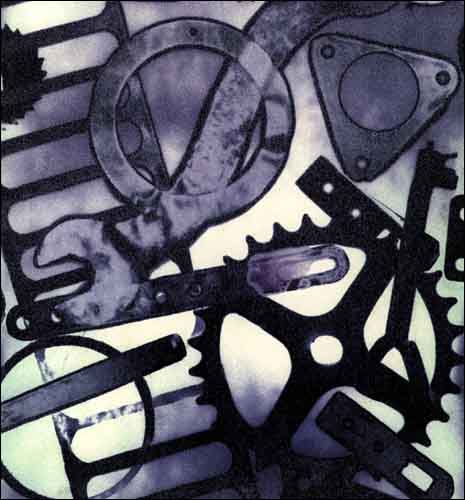
Klasycznie pojęta "fotografia artystyczna" straciła dla mnie sens - sens semantyczny. Stała się jedynie tworzywem. Dlatego posunięta subiektywna ingerencja "wytwórcy" fotogramu niweczy doszczętnie tak szanowane dotychczas pozory prawdy fotograficznej.
Józef Robakowski
(fragment treści ulotki towarzyszącej wystawie indywidualnej
pt. FORMY FOTOGRAFICZNE galeria ŁTF, Łódź 1970 rok)
Operacja na REALNOŚCI Józef Robakowski, 1999
Utrata wiarygodności obrazu fotograficznego jest już dzisiaj faktem oczywistym. Jego "moralność" ulega systematycznej degradacji. Szczególnie wszelkie interesownie podjęte manipulacje natury politycznej, ale też technicznej doprowadziły do sfingowanej "fotograficznej rzeczywistości cyfrowej". Symulowane obrazy binarne stały się dla wielu nową rzeczywistością, którą zaczęto powszechnie akceptować.
W tym miejscu przypomnę, że właśnie moje pokolenie (dzieci wojny) urodzone ok. 1939 roku miało niewątpliwie zakodowany w sobie dylemat: czy jeszcze wierzyć w tę - jak to twierdzili dobrze usposobieni powojenni "materialiści" - fotograficzną mumię realności, czy nie? Starsi - czyli oni - byli pewni, że tworzywem fotografii są obrazy zarejestrowanej rzeczywistości. Mieli za sobą "pozytywne" argumenty ideologiczne, ale też i naukowe, natury obiektywnej. Dla francuskiego teoretyka filmu i fotografii A. Bazina, foto-medium, to sama natura, jej wierny odcisk, niby maska pośmiertna. Dla amerykańskiej awangardzistki M. Deren w latach pięćdziesiątych fotografia była formą samej realności, bowiem obiekt stwarza, jej zdaniem, "własny obraz przez wypromieniowanie swego światła na światłoczuły negatyw". W tym procesie podobno udział człowieka jest absolutnie wykluczony. Stąd narodził się autorytet realności obrazu fotograficznego. Na tej umiejętnie podsuniętej nam "bazie" mogliśmy jako młodzi adepci sztuki fotograficznej bez przeszkód podjąć pracę artystyczną. Tymczasem ten materialistyczny błogostan niezmiernie skomplikował graniczny 1956 rok, gdyż wtedy właśnie pod wpływem wydarzeń polityczno-społecznych pojawił się w naszym kraju krytyczny ruch niezależnego myślenia. W kontekście oficjalnej kultury socjalistycznej następuje niespodziewanie (głównie na prowincji) samokształceniowy "ruch amatorów". Poza zawodowym (związkowym) układem zaczynają działać studenckie kluby, grupy twórcze
i stowarzyszenia. W Toruniu studenci UMK powołują między innymi placówki filmowe, fotograficzne i plastyczne. Zacieranie się granic między różnymi dyscyplinami stanowi nowy sens działań interdyscyplinarnych. Młodzi szybko zawiązują działające w całym mieście grupy twórcze: "Pętla", "OKO", "ZERO-61", "Rytm" i stowarzyszenie artystyczne "Krąg". Nasze METAFORYCZNE IDEE wspierane są przez przybyłych
z Wilna przedwojennych profesorów: T. Niesiołowskiego i S. Narębskiego. Natomiast interesujące dla nas problemy historyczne Młodej Polski omawiamy na Wydziale Sztuk Pięknych z prof. J. Puciatą-Pawłowską specjalizującą się w twórczości J. Malczewskiego i W. Wojtkiewicza. To wspólne odkrywanie zagadnień sztuki symbolicznej znajdzie swoje odbicie w naszych pierwszych gestach artystycznych zarówno w fotografii jak i w filmie. Oderwanie się od realiów politycznych i społecznych było naszym zwycięstwem. Brak perspektywy rekompensowaliśmy beztroską studencką zabawą w artystów. Odpowiadała nam wyraźnie postawa kontrapunktowa w stosunku do związkowej Grupy Toruńskiej
i "materialistycznych humanistów" skupionych w pracowni prof. S. Borysowskiego. Jako elementy przekory artystycznej uruchamialiśmy bardzo często strategię destrukcji klasycznego obrazu - ironię, pastisz, kicz, parodię, absurdalny humor sytuacyjny czy rysunkowy komiks. Do zamazywania granic mentalnych posługiwaliśmy się fikcyjną postacią pseudoartysty J. Korbieli, który zawsze był z nas najlepszy. Osobiście uwielbiałem absurdalne sytuacje prowokowane tzw. dziełami sztuki jak np. "Epitafium Jana Gnata", "Portret damy z naszyjnikiem" czy tablica
z naklejonym fotograficznym wizerunkiem durszlaka przebitym kilkucalowym gwoździem. Pod koniec lat sześćdziesiątych metaforycznie traktowana fotografia przestaje mi być potrzebna. Mieszkam już w Łodzi, gdzie studiuję na Wydziale Operatorskim Szkoły Filmowej. Pojawiają się nowe czasy i nowe problemy. Podczas ostatniej wystawy grupy ZERO-61 powołujemy dla nas miejską przestrzeń opustoszałej kuźni na ul. Podmurnej 32. Toruńską publiczność udało się zdezorientować. Dzieł jako takich na wystawie nie było. Kuźnia została zaanektowana przez stworzenie nowej przestrzeni mentalnej, na którą złożyły się między innymi bliżej niezidentyfikowane "dzieła-gesty". Znaleziona na terenie starej kuźni drewniana tablica stanowiła coś podobnego do epitafium anonimowej osoby (jej guzik, krawat, buty, spinka, pisany dokument, medalik, stare zdjęcie, sakiewka na pieniądze), a moje już tylko było opowiadanie fikcyjnego losu. Czerwona, żywa rybka pływająca w zwykłym słoiku umiejscowiona w zardzewiałej klatce po kanarku. Płaszcz matki postawiony jako bezimienna rzeźba. Wreszcie mój wizerunek natryśnięty na mur białą farbą. Fotografię zastąpiły przedmioty. Jej ostatecznej degradacji dokonałem na wystawie Fotografów Poszukujących (Galeria Współczesna - Warszawa 1971 rok) wkładając obraz fotograficzny wykonany na płótnie do dużego słoja z wodą. W efekcie po dwóch dniach emulsja spełzła na dno tego naczynia pozostawiając białe, czyste płótno. W następnych latach medium to potrzebne mi było jako FOTOGRAFIA ASTRALNA rejestrująca obrazy myśli, bólu i chorób zakaźnych różnych ludzi, albo narzędzie celnie dokumentujące własne pomysły natury konceptualnej w pracach fotograficznych z cyklu "Relacje". Teraz w dobie kryzysu obrazu fotograficznego, który tak wiele lat służył nam jako metoda werystycznego odbicia rzeczywistości podsuwam nową możliwość kontaktowego wizerunku w postaci GORĄCYCH OBRAZÓW. Wywołać je można na papierze pokrytym emulsją uczuloną termicznie przez przykładanie przedmiotów o podniesionej temperaturze. Inne obrazy pojawiają się na tym nowym materiale przez działanie gorącym powietrzem. Są wierne swojej prapostaci - mimo, że trudno tę wiarygodność na dłuższy czas zachować. Są nietrwałe, acz magiczne, ponieważ wymykają się naszej pełnej kontroli. Są piękne, kolorowe i nic nie znaczą, za co je bardzo kocham, a nazywają się TERMOGRAMAMI.
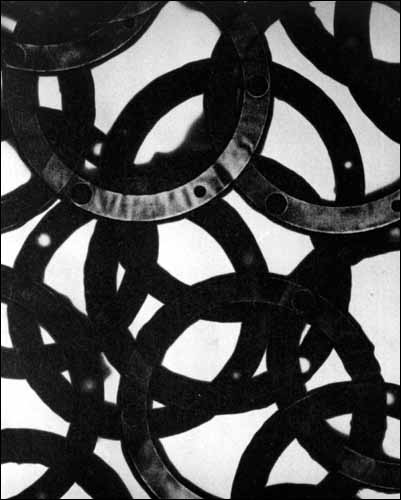
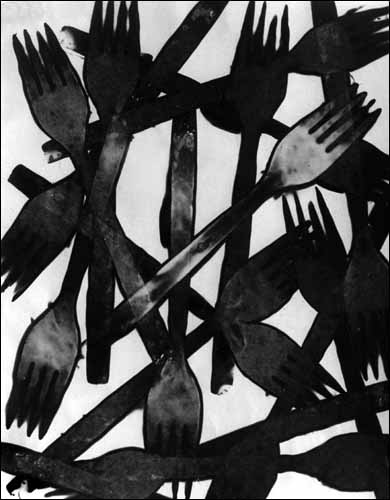
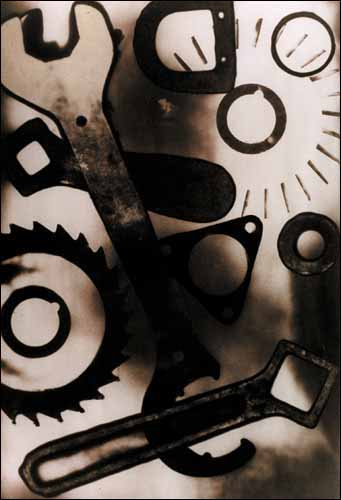
"Artistic photography", conceived in the classical sense, has lost its meaning as far as I am concerned - its semantic meaning. It has become merely a kind of material. That is why an advanced subjective intrusion of the "manufacterer" of a photogram totally annihilates the illusions of photographic truth so widely respected so far.
Józef Robakowski
(fragment of a leaflet accompanying his individual exhibition called "PHOTOGRAPHIC FORMS", shown at the gallery of the Łódź Photographic Association in Łódź, in 1970).
Operations on REALITY Józef Robakowski, 1999
The loss of credibility of the photographic image is an obvious fact today. Its "morality" undergoes systematic degradation. Especially all selfish manipulations of political, but also technical nature, have lead to the rise of a swinging "digital photographic reality". For many people simulated binary images have become new reality which is universally accepted nowadays. Let us remember, at this point, that it was my generation (the generation of "war children"), born around 1939, that undoubtedly had to live with a dilemma whether to believe - as kind-hearted post-war materialists would have it - in the photographic mummy of reality, or not? Our elders - those materialists, that is - were certain that the material of photography consists of images of registered reality. They were in possession of some "positive" ideological, but also scientific arguments, objective in nature. For the French theoretician of film and photography, A. Bazin, the photographic medium was nature itself, its faithful imprint, something like a death-mask. For the American avant-garde artist, M. Deren, active in the 1950s, photography was a form of reality itself, because an object, in her opinion, creates its own image by means of radiating its light onto a light-sensitive negative. The participation of man in this process was supposedly ruled out absolutely. Thus the authority of reality of the photographic image was born. We, young students of photographic art, could begin our artistic work without any obstacles on the part of those arguments, which were so skillfully presented to us. However, this materialistic state of bliss complicated things extremely in the critical year of 1956, when under the influence of political and social events a critical movement of independent thought appeared in our country. Suudenly, within the context of official socialist culture, there comes into being (mainly in the provinces) a self-educating "movement of amateurs". Beside the professional system of official associations many new student clubs, creative groups and societies begin to arise. In Toruń the students of the Nicolai Copernicus University found - among other organizations - film, photographic and artistic establishments. The erasure of the boundaries between various disciplines forms a new sense of interdisciplinary activities. Young people quickly establish creative groups like "Pętla" ("The Loop"), OKO ("The Eye"), "Zero-61", "Rytm" ("Rhythm") and an artistic association called "Krąg" ("The Circle"), active virtually everywhere in the city. Our METAPHORICAL IDEAS are supported by professor T. Niesiołowski and professor S. Narębski, who both had taught before the war in Vilnius. Historical problems of the period between 1919 and 1939 (the so-called Young Poland), most interesting for us, are discussed at the Department of Fine Arts with professor J. Puciata-Pawłowska. who specialized in the art of J. Malczewski and W. Wojtkiewicz. The fact that we discovered the problems of symbolic art together was later reflected in our first artistic gestures, both in photography and in film. We managed to break away from social and political reality, and that was our triumph. We tried to compensate the lack of perspectives by playing care-free artists. We clearly liked the counterpoint attitude, directed against the official Toruń Group and the "materialistic humanists", gathered around the workshop of professor
S. Borysowski. As elements of artistic contrariness we often employed the strategy of destruction of classical images - using irony, pastiche, kitsch, parody, absurd situational humour or comic strips. In order to erase mental boundaries we employed a fictitious figure of a pseudo-artist called J. Korbiela, who was always - naturally - the best of us all. Personally I loved absurd situations provoked by pseudo-artworks like "The Epitaph of Jan Gnat", "The Portrait of a Lady with a Necklace" or a board on which a photograph of a strainer pierced by a nail several inches long was pasted. At the end of the 60s I did not need metaphorically treated photography any more. I started living in Łódź and began studying at the Department of Cinematography of the local Film School. New times and new problems arise. During the last exhibition of the ZERO-61 group we evoked city space of an abandoned smithy at 32 Podmurna Street in Toruń. We managed to disorient the Toruń audience. Artworks as such were absent at the exhibition. The smithy was annexed by means of creating a new mental space which was constituted, among other things, by rather unclear "works/gestures". A wooden board, found in the old smithy, resembled something like an epitaph of some unknown person (along with his button, a tie, shoes, a cuff-link, a written document, a little locket, an old photograph, a money purse), while the story of his fictitious fate was mine and mine only. Moreover, a red, live fish, swimming in an ordinary glass jar, placed inside a rusty canary cage. My mother's coat standing upright as a plaster sculpture. And finally my very own image, squeezed in white paint onto one of the walls. An unnamed photograph was replaced by objects. I degraded it ultimately at the exhibition of Seeking Photographers (at the Contemporary Gallery in Warsaw in 1971), inserting
a photographic image on a piece of canvas into a large jar filled with water. The effect was that two days later the emulsion crawled onto the bottom of the jar, leaving a white, clean canvas. During the following years I needed this medium as ASTRAL PHOTOGRAPHY which registered images of thought, pain and contagious diseases of various people, or as an instrument that would record correctly my own conceptual ideas in my photographic works from the "Relations" series. But now, in the age of the crisis of a photographic image which for so many years had served us as a method of veristic representation of reality, I suggest a new possibility of a contact image in the form of "HOT IMAGES". They may be construed on paper covered with thermosensitive emulsion by means of touching it with objects heated to a higher temperature. Other images may appear on such paper when it is treated with hot air. They are faithful to their primary shape - although their physical credibility is difficult to retain for a longer period. They are unstable, but magical, because they escape our full control. They are beautiful, colourful and they mean nothing, but that is precisely what I love them for, and they are called THERMOGRAMS.
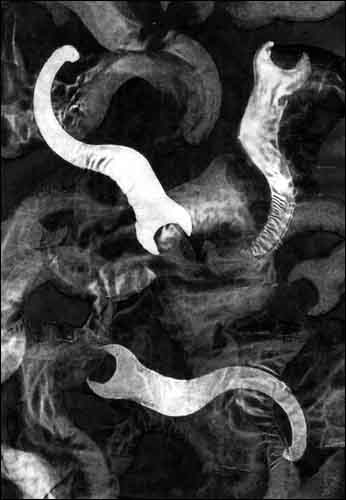
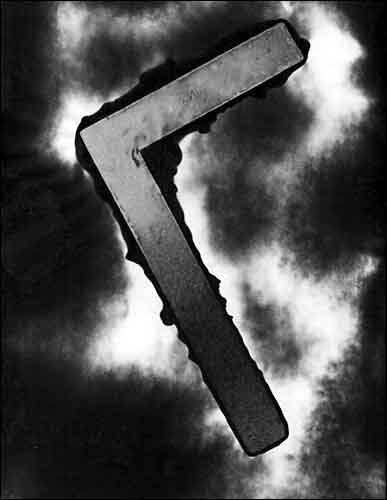
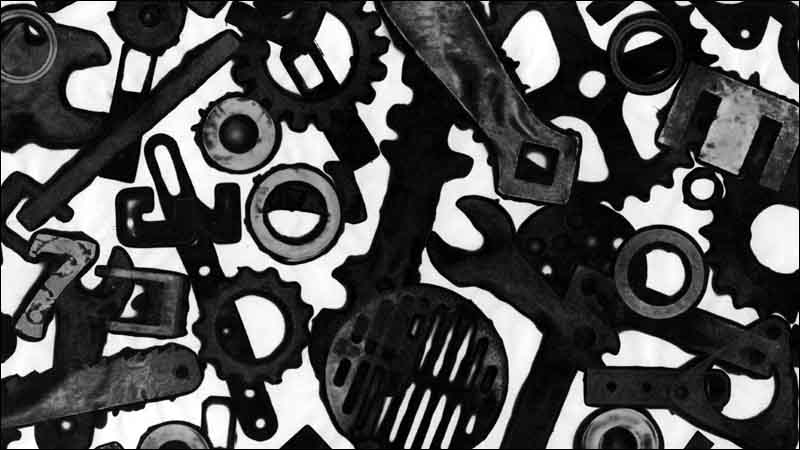
Galeria FF - Józef Robakowski
Informacja biograficzna
Kąty energetyczne
Copyright ©2000 Józef Robakowski, Galeria FF ŁDK